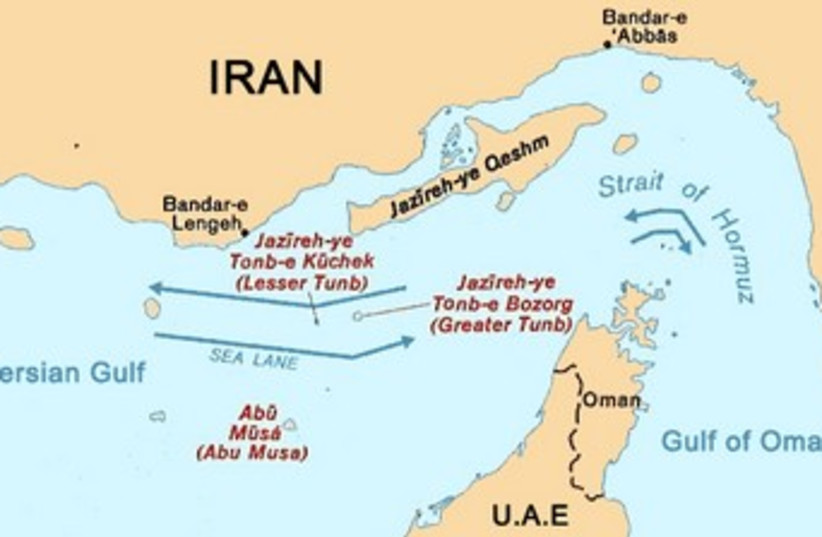Iran and the United Arab Emirates both reaffirmed their respective claims to the three contested Persian Gulf islands in the Strait of Hormuz during their speeches at the 77th annual United Nations General Assembly meeting last month.
UAE speaker, Minister of State for International Cooperation Reem bint Ibrahim Al Hashemy, discussed the dispute over the three islands, Abu Musa, Greater Tunb and Lesser Tunb.
"We renew our demand to end Iran's occupation of the UAE's three islands: Greater Tunb, Lesser Tunb, and Abu Musa," the Emirati speaker explained. "History and international law bear testimony to the UAE’s sovereignty over the three islands. We will never stop our legitimate claim to these islands, either through direct negotiation or through the International Court of Justice."
"We renew our demand to end Iran's occupation of the UAE's three islands: Greater Tunb, Lesser Tunb, and Abu Musa. History and international law bear testimony to the UAE’s sovereignty over the three islands. We will never stop our legitimate claim to these islands, either through direct negotiation or through the International Court of Justice."
UAE Minister of State for International Cooperation Reem bint Ibrahim Al Hashemy
Iran, however, was quick to fire back.

"The Emirati official's allegations and repetition of baseless claims concerning the Iranian islands in the Persian Gulf is tantamount to an attack on Iran's territorial integrity," the Iranian mission to the UN said in a statement, as reported by Iranian media.
Both statements underscore how important these three islands are to both countries.
But why are these islands so important to the UAE and Iran? What is the basis for both of their claims?
Here is what you should know.
<br>What are the three islands Iran and the UAE both claim?
The three islands of Abu Musa, Greater Tunb and Lesser Tunb are all relatively small and reside in the Persian Gulf.
Abu Musa, a 12.8 square-kilometer island, has a small population of just over 2,000 people living on it. The Greater Tunb, with an area of 10.3 square kilometers, and the Lesser Tunb, just two square kilometers, both have little to no inhabitants, aside from Iran military personnel.
Though the UAE claims sovereignty over them, with Abu Musa belonging to the Emirate of Sharjah and the Tunbs belonging to the Emirate of Ras Al Khaimah, all three islands are de facto controlled by Iran and are administered as part of the Hormozgan Province.
Despite the islands being small and having little in the way of natural resources or population, they are highly valued for their key strategic location in the Strait of Hormuz, arguably the most vital waterway in the world.
The reason for their importance is that in order to get through the Strait of Hormuz, connecting the Persian Gulf to the rest of the world, oil tankers and other big ships need to pass between these three islands.
This, in turn, makes them essential for controlling the waterway.
But what are the claims behind them?
<br>Why does the UAE claim the islands?
The islands have maintained a long presence throughout regional history as both controlled by Arab tribes and the Persian Empire at different times. However, control over them was largely held by the Al Qasimi family, an Arabian royal dynasty that has been in power in some form or another for 300 years.
The Qasimi were a maritime power in the Persian Gulf and were heavily involved in regional affairs.
Eventually, their holdings were incorporated into the Trucial States, which largely became part of the confederation that were largely British protectorates, all of which would soon go on to become the UAE in 1971.
To this day, the Qasimis still rule two of the seven emirates that make up the UAE, Sharjah and Ras Al Khaimah. As such, the UAE claims that their holdings are rightful Emirati territory.
Why does Iran claim the islands?
Iran's claims are rooted in the islands having been part of the Persian Empire for thousands of years. How true this is isn't clear, since pre-colonial sovereignty records don't exist. The earliest records put the islands under Arab control in the 1500s.
Further, Iran also claims that the Qasimis who ruled the area were actually based in the Iranian side of the Persian Gulf, and as such, they were Persian subjects and the islands would therefore come to Iran.
Iran also cites a Memorandum of Understanding signed with Qasimi leaders in 1971 to share the island, though Iran quickly launched a military invasion to seize control of them.
Currently, that is where this stands, and Iran has remained in control of the islands for over 50 years.
<br>Who recognizes the UAE's claims?
While all attempts at international relief through the International Court of Justice or United Nations have failed thus far, the UAE can boast the support of a number of countries for their claims, especially from the broader Arab world.
However, due to the long history of the islands and their strategic value, as well as the UAE being aligned against Iran in the broader scope of Middle Eastern geopolitics, Iran is unlikely to willingly give the islands up any time soon.
